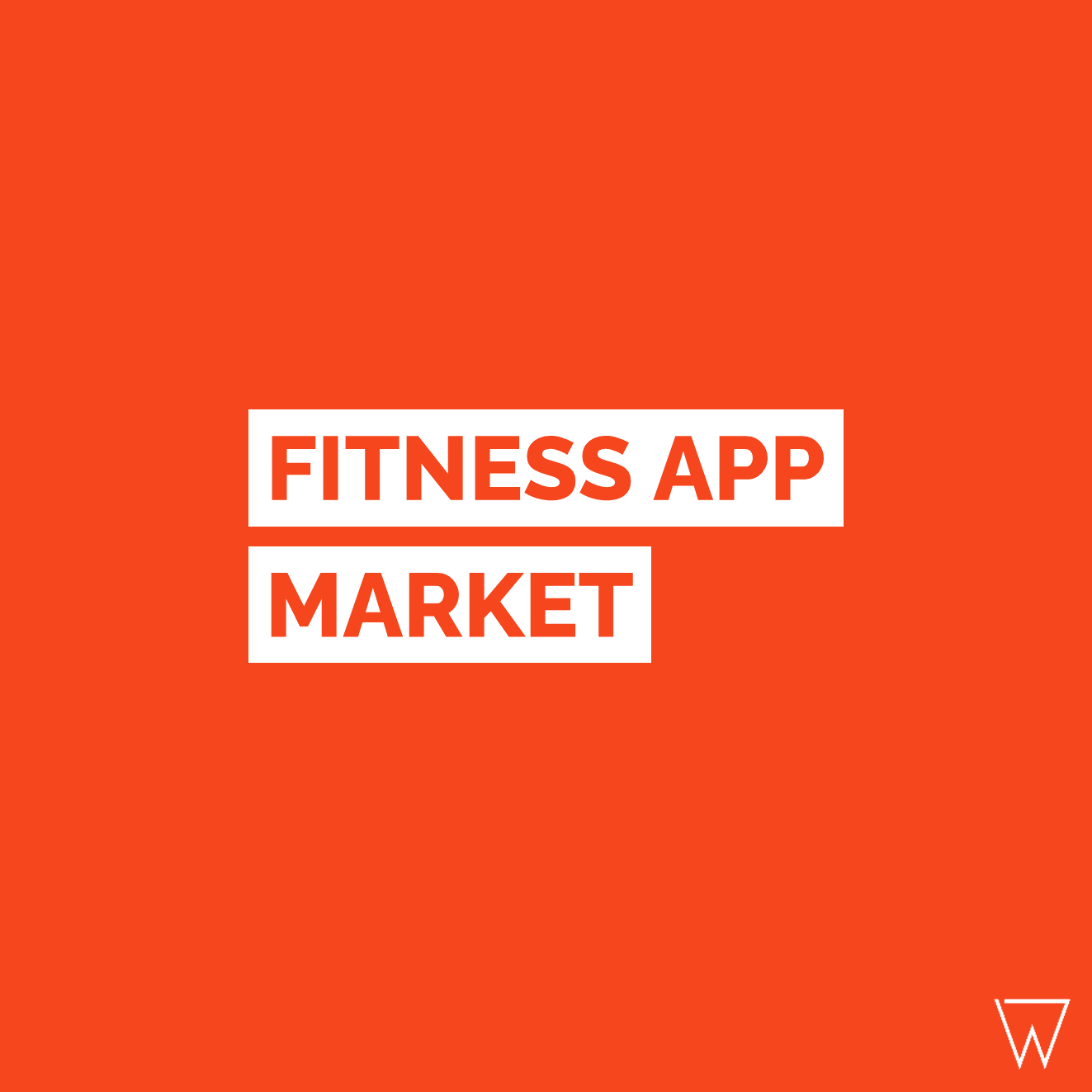The health and fitness app market is growing at an impressive rate. These digital companions are no longer just tracking steps and distance – they’re transforming how people approach wellness.
In this article – we explore the global fitness app market, including its size, growth, leading players, trends, and what the future holds.
Fitness App Market Size & Growth
The health and fitness app market has witnessed a remarkable surge in recent years, becoming a billion-dollar industry that continues to expand.
- The fitness app market is worth $19.3bn in 2023 and growing at a rate of 14.3%.
- It’s predicted to be worth $33bn by 2027.
- Almost 1 in 10 people (9.76%) use a fitness app in 2023 and this is expected to reach 12.2% by 2027.
- The average revenue per user (ARPU) is $25.78 (which jumps to $70.20 if we just look at paid apps) with most being generated in China ($5.5bn).
The fitness app market’s growth is being driven by a number of factors including the increasing awareness of health and wellness, convenience of mobile solutions, and integration of advanced technologies like AI and fitness wearables.

2023 Fitness Industry Report
The most comprehensive and up-to-date report on the fitness industry available. Includes revenue, growth, and future predictions plus much more.
Fitness App Market Segments
The fitness app industry caters to a wide range of health and wellness needs that address specific aspects of well-being. In terms of fitness app market segmentation:
- Fitness tracking apps take the lead, offering users the ability to monitor their daily activities, from step counts to heart rate, providing valuable insights into their overall health.
- Workout apps follow closely, providing guided exercise routines, from high-intensity interval training to yoga and everything in between.
- Diet and nutrition apps empower users to make healthier dietary choices, offering meal planning, calorie tracking, and personalised diet recommendations.
- The mindfulness segment has been gaining prominence, with apps designed to reduce stress, improve mental well-being, and aid relaxation through meditation and sleep tracking features.
While fitness tracking and workout apps have a broad and well-established user base, mindfulness apps have seen rapid growth in recent years. This likely reflects an increasing awareness of mental health and growing consumer interest in holistic wellness.
You might also like… Fitness Industry Insights, Nutrition Market Stats, or Exercise Industry Overview.
Leading Fitness App Players
There are several leading players in the industry. In terms of fitness app market share, Strava, Fitbit, and FitCoach dominate with 16%, 10%, and 6% respectively. MyFitnessPal and Nike Training Club have also secured significant portions of the market.
- Strava & Fitbit – both excel in wearables, integrating seamlessly with their apps to provide holistic health tracking experiences.
- MyFitnessPal – known for its comprehensive food tracking and calorie counting capabilities, boasts a massive user base.
- Nike Training Club – backed by the renowned sportswear brand, offers a curated library of workouts led by professional trainers.
- Headspace & Calm – are two of the most popular meditation apps across both Apple and Android stores.
Successful health and fitness apps share some common traits. These include a focus on user engagement, gamification elements, personalised recommendations, and integration with fitness equipment and other tech devices.
Fitness App Market Trends & Future Outlook
The digital nature of fitness apps mean they can evolve and transform rapidly. On the plus side, this means they can tap into emerging fitness trends quickly and capitalise immediately. The downside is that competitive is fierce – there’s always a new app around corner that’s looking to be the next big thing.
Key trends in the market currently are…
- Integration with wearable devices – whether it’s syncing your daily step count with your smartphone or monitoring heart rate during workouts, wearables have become indispensable tools for fitness enthusiasts.
- Virtual fitness classes – are revolutionising the way we exercise, bringing the gym experience into our homes. From live-streamed yoga sessions to interactive HIIT workouts, virtual classes offer convenience and flexibility.
- Holistic wellness – the shift towards holistic wellbeing, where consumers consider wellness pillars more broadly (instead of just traditional diet and exercise silos), is impacting the entire fitness market.
- Artificial intelligence (AI) – is powering personalised workouts and data-driven recommendations, using algorithms to analyse user data (activity levels, preferences, health metrics) to tailor fitness plans and nutrition advice.
- Data privacy – consumers are becoming more wary of companies harvesting their personal data and governments have introduced a number of privacy laws that apps need to comply with, so developers are responding by implementing stringent data protection protocols, cutting-edge encryption technologies and user consent mechanisms.
These trends collectively enhance user engagement by offering more interactive, data-driven, and customised fitness experiences. For app developers, this means a heightened focus on seamless integration, improved user interfaces, and AI-driven features that adapt to individual needs.
Fitness App Market Analysis
The future of fitness apps looks promising given the rapid market growth predictions and potential for continual innovation. From fitness tracking to personalised workouts, diet management, and mindfulness support, fitness apps cater to a wide spectrum of needs.
Looking ahead, advancements in AI and machine learning will enable even more personalised and effective fitness plans. Wearable devices will become increasingly sophisticated, seamlessly syncing with apps to provide real-time feedback and insights. Emerging technologies like augmented reality (AR) and virtual reality (VR) are also poised to reshape the landscape.
The trend towards holistic well-being will likely mean that fitness apps integrate mental health and mindfulness features, catering to the growing demand for stress management and relaxation tools.
As with any market, brands that innovate and adapt quickly will maintain their competitive advantage. Apps will need to blend user-centric design, data-driven personalisation, and strategic marketing to stay ahead. Combining innovative features, seamless usability, and a supportive user community will continue to help apps achieve both growth and user satisfaction.
Fitness Industry Research Report
This is the most comprehensive and up-to-date industry research report available. Unlike others, you get extended access to the 2023 edition, including any updates that are made as new market data becomes available. Ideal for business planning, the report includes;
- Industry growth, revenue & future predictions
- Online & virtual fitness market developments
- Impact of recent global events & estimated recovery timelines
- Number of gyms, members & retention statistics
- Growth markets, segments & audiences including Millennials
- Latest industry trends & how to capitalise on them
- Financial information for the largest club operators globally
- Biggest & fastest growing fitness franchises
- Insights into the personal training & boutique market segments
- Data on fitness product, equipment & wearables markets
- Evidence-based predictions for the future of the industry
- 14-day money-back guarantee, no questions or hassle

2023 Fitness Industry Report
The most comprehensive and up-to-date report on the fitness industry available. Includes revenue, growth, and future predictions plus much more.

Sources
Statista.

 АРХИВ
АРХИВ БОКС И ЕДИНОБОРСТВА
БОКС И ЕДИНОБОРСТВА Игровые виды спорта
Игровые виды спорта КАРДИОТРЕНАЖЕРЫ
КАРДИОТРЕНАЖЕРЫ МАССАЖНОЕ ОБОРУДОВАНИЕ
МАССАЖНОЕ ОБОРУДОВАНИЕ МЕДИЦИНА РЕАБИЛИТАЦИЯ
МЕДИЦИНА РЕАБИЛИТАЦИЯ СВОБОДНЫЕ ВЕСА
СВОБОДНЫЕ ВЕСА СИЛОВЫЕ ТРЕНАЖЕРЫ
СИЛОВЫЕ ТРЕНАЖЕРЫ Соревновательное оборудование
Соревновательное оборудование СПОРТ ДЛЯ ДЕТЕЙ
СПОРТ ДЛЯ ДЕТЕЙ СПОРТИВНОЕ ПИТАНИЕ И АКСЕССУАРЫ
СПОРТИВНОЕ ПИТАНИЕ И АКСЕССУАРЫ УЛИЧНЫЕ ТРЕНАЖЕРЫ
УЛИЧНЫЕ ТРЕНАЖЕРЫ ФИТНЕС И АЭРОБИКА
ФИТНЕС И АЭРОБИКА